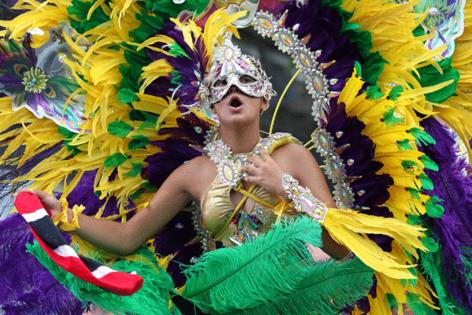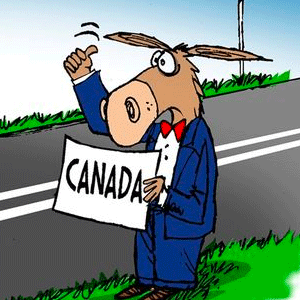Miami Carnival feels the pinch from tariffs and immigration fears
Published in News & Features
MIAMI — Those beaded and feathered costumes that parade throughout Miami Carnival may be fewer and farther between this year, as organizers say rising costs and immigration fears are dampening participation in the Caribbean cultural celebration.
Tariffs on imported materials, a sluggish economy and heightened immigration enforcement have combined to create a financial and logistical squeeze for both festival organizers and attendees. Costumes are more expensive to produce, bands are merging to cut costs, and some revelers — including international visitors and undocumented residents — are staying away altogether, worried about the possibility of U.S. Immigration and Customs Enforcement raids. Organizers say the result will likely be lower turnout and a scaled-back celebration compared to years past.
This weekend’s festivities are the final stop along the carnival circuit. Miami Carnival typically sees about 100,000 revelers celebrating Caribbean heritage and culture with pageantry, music, food and arts and crafts during the three-day affair spanning Columbus Day weekend.
Miami Carnival marketing director John Beckford said the festival has had to make some concessions to keep the event affordable. Last weekend’s Junior Carnival event was free, and this year revelers are allowed to purchase less expensive alternative outfits. And instead of having a Pan Competition, the festival will hold a Pan Jamboree that will still highlight signature steel bands.
“We cut back in some areas to kind of save on costs so that we don’t have to raise ticket prices and pass along the increased expenses of producing Carnival,” Beckford said, noting that this year’s budget is more than $2.5 million.
Beckford said last year’s numbers were down 32% compared to 2023 due to two hurricanes that hit Florida. And while he’s optimistic that clearer weather may bring the 97,000 revelers Miami Carnival saw two years ago, he’s realistic about the economic and political challenges facing participants.
Mas bands and designers feel the squeeze
The festival, which has been going for 41 years, typically has between 20 and 30 mas bands represented, but Nigel Alfred, president of the South Florida Band Leaders Association, said that number is 14 this year as some mas bands have combined to offset costs. (Miami Carnival’s website lists just over 20 bands participating.)
“Our members collectively spend well over $3.5-$4 million to put this on,” he said. “It is not a cheap offering. We have to find ways to keep that cost down as best as possible.”
Alfred said the overall costs of carnival have ballooned in part because of rising costs of food and rental for the trucks and sound systems used for carnival, among other expenses.
Some costume designers are also experiencing a financial tug. Lila Nikole’s costumes typically run as high as $750. This year, with costs going up due to tariffs, Nikole has had to get creative by using a 3-D printer to produce acrylic and resin beads that are typically purchased from China.
“We’re just figuring ways to do them,” she said. “Maybe, instead of 1,000 pieces glued to something, all the pieces are already designed in this 3-D printed type of aspect.”
Nikole said the printer has helped her keep her costs down so she doesn’t increase them for people who still want to attend carnival. Despite economic challenges, Nikole said her costumes have sold well.
Still, she said designers are seeing fewer requests. “This year is probably the smallest amount for the whole carnival industry,” she said. “It’s probably down 40% everywhere in general.”
Immigration enforcement could chill attendance
Financial issues aren’t the only factor that could affect attendance. Organizers say stepped-up immigration enforcement is keeping participants away.
“I think even for people who have nothing to ‘quote-unquote’ worry about, they just don’t want to be at a venue that they might get caught up as collateral damage,” he said. “So there’s definitely a chilling effect.”
Alfred added that international visitors — even from places like Nigeria and Saudi Arabia — are hesitating, and undocumented residents who once found refuge in Miami Carnival are staying home.
“These folks are not taking that chance to travel out here to come,” he said. “One of our biggest concerns would be if ICE is going to set up shop outside the carnival gate and bother people in costumes. I don’t know, but those things obviously have played a role in depressing numbers and volumes of people.”
Alfred said he hopes to see more sponsorships in the future to help offset costs and sustain Junior Carnival, which he called essential to the event’s future.
Beckford noted that sponsorships has been a challenge, with many companies afraid of the backlash at the federal level from supporting cultural events, but he said Carnival is still a moneymaker for South Florida and estimated the economic impact to be about $127 million.
“So, the federal government might not care about culture anymore, but I think at the end of the day, you have to shine a spotlight on the economic impact that Miami Carnival brings to the tri-county area.”
More information about Miami Carnival is available at https://miamicarnival.org/
_____
©2025 Miami Herald. Visit miamiherald.com. Distributed by Tribune Content Agency, LLC.







Comments